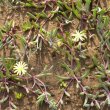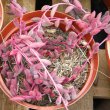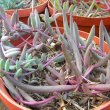| Botanical Name |
Othonna capensis Hybrid - Ruby Necklace |
| Family |
Asteraceae - The daisy family. |
| Pronunciation |
|
| Common Name(s) |
|
| Plant Group |
- Climber / Creeper Climber: a plant that climbs using tendrils or if given support.
Creeper: a plant running along the ground, often rooting as it goes.
- Succulent A plant having fleshy stems or leaves often adapted to dry conditions.
|
| Plant Size |
- Very Small
| Tree | 3m to 4m |
| Shrub | 25cm to 50cm |
| Perennial/ground cover | Up to 10cm |
| Bulb | 10cm to 20cm |
| Succulent | Up to 5cm |
|
| Position |
- Partial Shade The area is in shade for part of the day and in full sun for part of the day.
- Sun The area is in full sun for all or most of the day, all year round.
|
| General Information |
- Drought Tolerance: High The plant is well adapted to arid conditions; it can survive long periods of drought and high temperatures without extra water.
- Evergreen Plants that have leaves all year round.
- Frost: Half-hardy The plant is able to survive low temperatures and some frost but requires protection against severe frost.
- Water Wise Plant species originating from low rainfall regions that require less water to survive and thrive than other plant species.
|
| Specific Information |
The plant tolerates a little shade, but in too much shade it will grow lanky and less likely to mat, as it tries to reach the sun.
|
| Ad Break |
|
| Flowers |
| Description |
|
| Season |
- All Year Plants will seldom bloom for the entire season as given in the list, but should flower during a period within these parameters.
|
| Colour |
|
| Growth Rate |
- Very Fast Specifying growth rate can be very misleading as there is considerable variation of growth rate depending on type and species of plant, available water, supplementary feeding, mulching and general care, as well as the plants suitability and adaptability to the garden environment.
|
| Plant Uses |
- Container Trees, shrubs and ornamental species that can adapt to growing in a restricted environment.
- Foliage Plant Plants grown because their foliage is colorful or unique. Many of these plants have insignificant flowers.
- Ground Cover Low-lying plants that spread fast, require minimal maintenance, and cover large expanses or bare areas between bulbs or shrubs. They provide protection from erosion and drought and improve the visual appearance of the garden.
- Mass Planting Plants useful for filling a large area with just one or a few kinds of plants spaced close together. Creates a bold, dramatic effect and to reduces maintenance.
- Pioneer for new gardens A very fast growing plant, able to withstand hardship, that can be used to populate land that has recently been cleared of natural vegetation. These plants pave the way for slower-growing species by adding nutrients to the soil and creating leaf litter.
- Pot Plant A plant that needs a protected environment on a patio or indoors.
- Retaining Walls Shallow rooted plants for cascading over dry stone walls or planting in hollow spots in retaining blocks.
- Rock Garden An area constructed of larger rocks, arranged naturally, to emphasise the use of stones as a main element. Generally plants used do not need a lot of care.
- Suitable for coastal gardens Plants adapted to dry, sandy soil, forceful wind, limited rainfall and intense sunlight.
- Wild Garden An indigenous garden planted for the benefit of wildlife and birds. Provides food, water, a variety of mini-biomes and no poisonous chemicals are used.
|
| Distribution and Habitat |
Hybrid of Othonna capensis which is found in the Eastern Cape.
|
| Planting Suggestions |
Plant in full sun in well drained soil with a little compost if the soil is very poor. Keep just moist until established then water only when the soil is dry. If over-watered, this little creeper will gallop along and very soon outgrow its allotted space. Plant in full sun and withhold water if you wish to develop the lovely red colour.
|
| Medicinal Uses |
|
| Ad Break |
|







Comments
Very interesting blog
Very interesting, thanks for sharing.
Discuss this plant
Share knowledge, ask a question or give an experience.